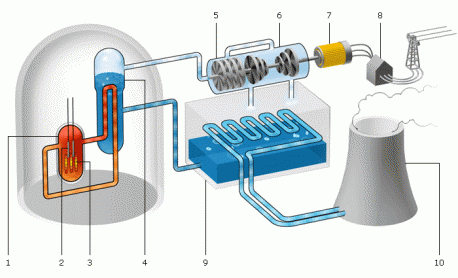Beznau and Gösgen nuclear power plants must check their steam generators
The Swiss Federal Nuclear Safety Inspectorate (ENSI) requires that the Beznau and Gösgen nuclear power plants check the quality and design of the forgings of the steam generators in respect of adherence to the material specifications. In doing so, ENSI is reacting to information from France.
“Thus far we have no evidence to indicate that the steam generators in Beznau and Gösgen are affected by impermissible deviations in the material properties,” Georg Schwarz, ENSI Deputy Director and head of the NPPs Division, emphasises. To gain an overview, ENSI requires the in depth review of the manufacturing documents. Of interest here is information about the affected components: manufacturer, manufacturing period, material, applied design specification and regulations, deviations during the manufacture, manufacturing with details of the forging process, the size of the ingots, acceptance tests carried out including test certificates, test requirements, inspection company and acceptance authorities. Furthermore, the non-destructive testing of the material for further clarification of the facts is needed.
The review results of the manufacturing documents must be handed in to ENSI by the end of April 2017.
Steam generator
Pressurised water reactors, such as those in Gösgen and Beznau , are operated with two separate circuits, the primary and secondary circuits. While in the primary circuit pressurised water is heated by the heat from the fuel rods, it is the secondary circuit that is responsible for steam generation. Steam generation takes place in the steam generator (no. 4 in the figure), where the hot water from the primary circuit flows through thin tubes and so transfers its heat energy to the water in the secondary circuit on the other side of the tubes.

Mühleberg and Leibstadt nuclear power plants are boiling water reactors and do not have steam generators.
Too high carbon content in the steel
At the end of September 2016, the French Nuclear Safety Authority ASN issued a Statement, confirming that results of quality control checks on multiple forged parts of steam Generators have revealed areas with heightened carbon content. Heightened carbon content can lead to that the steel no longer conforms to the original design specifications especially with respect to the notched impact strength and fracture toughness.
The heightened carbon content can be caused by separation (positive segregation) during the manufacturing of the material. According to the information provided by ASN, components for steam generators made in the forging works Le Creusot Forge and Japan Casting & Forging Corporation JCFC are affected.
The review in France revealed that potentially vulnerable forgings from Le Creusot Forge and JCFC have also been installed in foreign nuclear power plants. “This prompted us to instigate inspections of the steam generators at Beznau and Gösgen,” Georg Schwarz explained.
The Beznau steam generators were replaced in the 1990s. Those that are currently in use were partly produced in the Le Creusot Forge. The components in the Gösgen steam generator originate from German forges.
Documents checked for completeness in summer 2016
In June 2016, ENSI requested that the plants gather information and check whether components from the Le Creusot Forge with possibly incorrect production documentation were or still are in use. All plants could confirm that the manufacturing and material certificates for all forgings used for the safety-relevant main components are fully documented.

